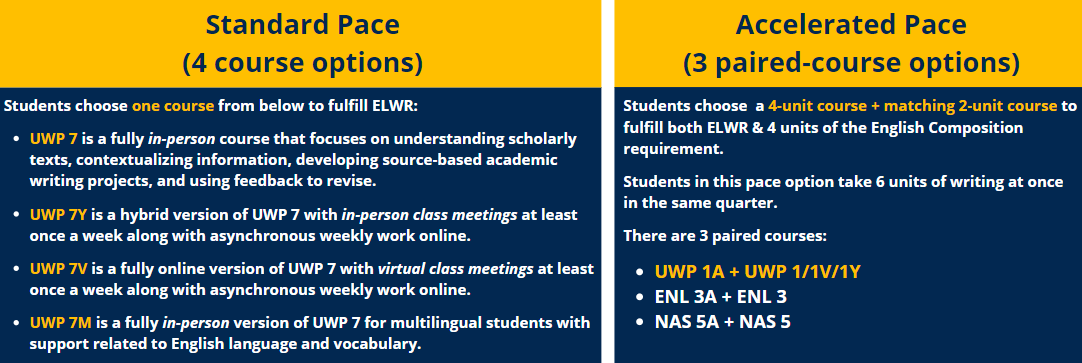Entry Level Writing Pathway Information
There are several different ELWR fulfilling courses you can take at UC Davis. This page describes them so you can make an informed decision.
What course can you take?
There are two options for pacing (standard and accelerated) in the ELW Pathway. Each pacing option has corresponding courses or paired-courses that students can choose from to satisfy ELWR.

What will you learn?
Courses in the Entry Level Writing (ELW) pathway fulfill the Entry Level Writing Requirement (ELWR) and are designed to support writers who need more experience in college-level academic reading and writing. These courses will help you further develop the strategies you need to be successful in the writing and reading you will do in future courses, regardless of the topic or major.
ELW students learn to
- identify and respond effectively to different kinds of academic writing tasks
- use strategies for reading and comprehending difficult academic readings
- use writing strategies for different audiences, purposes, and types of writing
- understand, interpret, and use feedback from both peers and teachers
- determine which sources will best support your purpose within a piece of writing
- bring together different sources to show a broader view of a topic
- cite sources ethically depending on the writing task
- choose the language that will best suit a particular writing task
- use strategies for editing writing for clarity and accuracy.
How will you learn?
An example assignment from an ELW course is a synthesis project. Students read and analyze several texts about a common topic from a collection provided by the instructor, learning to contextualize each text in the conversation. The goal of the project is for students to examine the various perspectives expressed by scholars in the texts and consider the relationships between these different viewpoints.
In order to complete this assignment, students need to…
- read and comprehend several complex academic texts in different forms or genres
- analyze the similarities and differences (or trends) in the perspectives expressed in the texts
- develop and support their own claims about what the trends between the texts suggest about the topic.